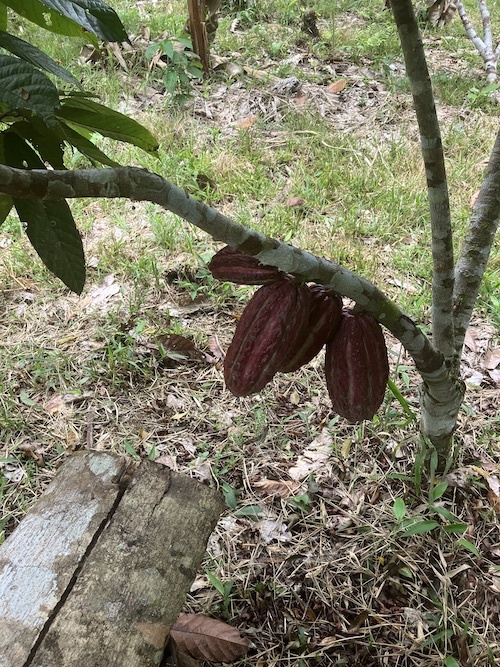Amazonian cacao for your Valentine's Day
Feb. 14th, 2024 10:07 amApparently I never shared these pictures here! But what better day than Valentine's Day, when people give chocolate to one another.
As you no doubt know, a lot of chocolate is produced using cacao that's obtained and grown in ways that are exploitative and bad for the environment. What I saw, though, was small family production--probably just for local consumption.
Like coffee, cacao *can* be a very beneficial crop to cultivate because it can grow in the shade of larger trees. It can be a forest-preserving crop. (Of course that's not what Big Chocolate encourages.)
Here is a small cacao tree with some cacao pods on it.

If you cut open one of those pods, this is what you see. The milky fruit is **delicious** (and tastes nothing like chocolate. It's full of flavor and reminds me slightly of a mangosteen.) What makes us chocolate are the pips--the beans--in the center of the fruits. Each pod has a bunch of these, as you can tell from how the fruit is packed in there.

Here are pips, drying in the sun. Apparently the recommended process is to ferment the beans and fruit together and then to dry them. So these have probably been fermented. (Obviously if you do that, you don't get to enjoy the fruit!) Some farmers, though, just dry the pips without fermenting them first. According to the article I read, that results in the pips being "overly bitter and astringent." But if you're growing just for your own purposes, you can do as you please. So maybe these pips haven't been fermented.

I had no chocolate when I was there, but my tutor often has chocolate con pan for her breakfast, by which she means hot chocolate: cocoa powder added to boiling water, with then as much milk powder and sugar added as you like. I've tried preparing it that way: it's nice!
As you no doubt know, a lot of chocolate is produced using cacao that's obtained and grown in ways that are exploitative and bad for the environment. What I saw, though, was small family production--probably just for local consumption.
Like coffee, cacao *can* be a very beneficial crop to cultivate because it can grow in the shade of larger trees. It can be a forest-preserving crop. (Of course that's not what Big Chocolate encourages.)
Here is a small cacao tree with some cacao pods on it.

If you cut open one of those pods, this is what you see. The milky fruit is **delicious** (and tastes nothing like chocolate. It's full of flavor and reminds me slightly of a mangosteen.) What makes us chocolate are the pips--the beans--in the center of the fruits. Each pod has a bunch of these, as you can tell from how the fruit is packed in there.

Here are pips, drying in the sun. Apparently the recommended process is to ferment the beans and fruit together and then to dry them. So these have probably been fermented. (Obviously if you do that, you don't get to enjoy the fruit!) Some farmers, though, just dry the pips without fermenting them first. According to the article I read, that results in the pips being "overly bitter and astringent." But if you're growing just for your own purposes, you can do as you please. So maybe these pips haven't been fermented.

I had no chocolate when I was there, but my tutor often has chocolate con pan for her breakfast, by which she means hot chocolate: cocoa powder added to boiling water, with then as much milk powder and sugar added as you like. I've tried preparing it that way: it's nice!